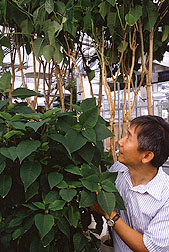The Secret of Free-Branching Poinsettias
|
|
Even though poinsettias are sold for only about 1 month a year, these Christmas time favorites are among the highest grossing ornamental crops in the United States, generating over $200 million annually in wholesales.
In plant pathologist Ing-Ming Lee's opinion, much of the credit should go to a microscopic tenant of the poinsettia plant: phytoplasma. Recent studies by Lee and others suggest that these bacteria without cell walls trigger a hormonal imbalance responsible for forming squat, full-bodied poinsettia plants with many flowering branches--precisely the aesthetic qualities American consumers desire.
"The phytoplasma is essential to both the plant's beauty and its commercial value," says Lee, who is at Agricultural Research Service' Molecular Plant Pathology Laboratory in Beltsville, Maryland.
By opening the floodgates for two growth-regulating hormones to wash into the plant's system, he says, the phytoplasma triggers the formation of axillary branches in a process called free-branching. So the plant grows outward, rather than up.
"These hormones have to be in just the right proportion to one another for the plant to display what would be normal growth," Lee explains.
In its native Mexico, the tropical plant reaches 8-plus feet, resembling a small tree. But a dwarfed form about 16 to 18 inches high adorns the tabletops and windowsills of U.S. homes. These free-branching, Americanized poinsettias also produce more brilliant-red bracts than their tropical cousins.
Initially, researchers credited free-branching to an "unidentified biological agent."
One suspect was the poinsettia mosaic virus, a well-known resident of more than 20 commercial cultivars. It was suspected because heat treatment of plants eliminated both the virus and the free-branching growth habit.
Until recently, says Lee, little substantial evidence had surfaced to truly challenge the virus' claim to fame. Other than its alleged role in free-branching, the virus possesses few redeeming qualities. For example, under certain conditions it can cause a disease that distorts the shape and color of the poinsettia's leaves.
Now, however, florists won't have to put up with this viral "necessary evil," thanks to the research of Lee, ARS colleague Dawn Gundersen-Rindal, and a team of collaborating scientists led by Michael Klopmeyer, of Ball FloraPlant in West Chicago, Illinois.
Not only did they show conclusively the poinsettia mosaic virus plays no part in free-branching, they developed a method for keeping it out of poinsettia breeding stock. That's something florists hadn't managed to do without sacrificing the phytoplasma in the process, says Lee.
The scientists' new method of propagating virus-free poinsettias arose from cross-grafting experiments in which they first identified the phytoplasma's role in free-branching--compliments of genetic fingerprinting techniques Lee developed.
Their experiments called for using a parasitic vine called dodder as a bridge between poinsettia and periwinkle plants. Lee says the disease-free periwinkle serves as an intermediary gatekeeper, stopping the virus in its tracks but allowing the phytoplasma safe passage, via dodder, into uninfected poinsettia plants. There, the new arrivals quickly activate their host's free-branching machinery.
Lee says florists could duplicate this approach on a commercial scale to produce a whole new generation of virus-free, free-branching poinsettias from a single mother plant infected by the phytoplasma--"a rare case where a pathogen is actually beneficial," he says.--By Jan Suszkiw, Agricultural Research Service Information Staff.
Ing-Ming Lee is at the USDA-ARS Molecular Plant Pathology Laboratory, Bldg. 011A, 10300 Baltimore Ave., Beltsville, MD 20705-2350; phone (301) 504-6024, fax (301) 504-5449.
"The Secret of Free-Branching Poinsettias" was published in the December 1998 issue of Agricultural Research magazine.







